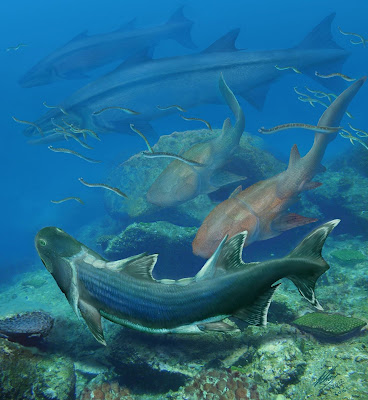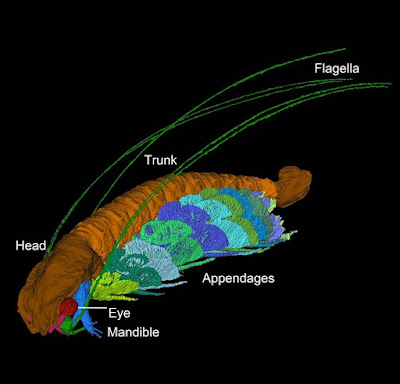 |
| Sparalepis tingi Choo, Zhu, Qu, Yu, Jia & Zhao, 2017 Illustration by B. Choo blogs.plos.org/PaleoComm |
Abstract
Our understanding of early gnathostome evolution has been hampered by a generally scant fossil record beyond the Devonian. Recent discoveries from the late Silurian Xiaoxiang Fauna of Yunnan, China, have yielded significant new information, including the earliest articulated osteichthyan fossils from the Ludlow-aged Kuanti Formation. Here we describe the partial postcranium of a new primitive bony fish from the Kuanti Formation that represents the second known taxon of pre-Devonian osteichthyan revealing articulated remains. The new form, Sparalepis tingi gen. et sp. nov., displays similarities with Guiyu and Psarolepis, including a spine-bearing pectoral girdle and a placoderm-like dermal pelvic girdle, a structure only recently identified in early osteichthyans. The squamation with particularly thick rhombic scales shares an overall morphological similarity to that of Psarolepis. However, the anterior flank scales of Sparalepis possess an unusual interlocking system of ventral bulges embraced by dorsal concavities on the outer surfaces. A phylogenetic analysis resolves Sparalepis within a previously recovered cluster of stem-sarcopterygians including Guiyu, Psarolepis and Achoania. The high diversity of osteichthyans from the Ludlow of Yunnan strongly contrasts with other Silurian vertebrate assemblages, suggesting that the South China block may have been an early center of diversification for early gnathostomes, well before the advent of the Devonian “Age of Fishes”.
Holotype and only specimen: V17915, a partial postcranium (Fig 2), with associated cleithrum, interclavicle and pelvic girdle. Institute of Vertebrate Paleontology and Paleoanthropology (IVPP), Beijing.
Diagnosis: Bony fish with spine-bearing dermal pectoral and pelvic girdles. Large median dorsal plates, with those immediately anterior to each the two dorsal fins bearing a large spine. Dermal surfaces of the scales and bony plates composed of glossy enamel ornamented with coarse sub-parallel ridges. Large surface pore openings within inter-ridge furrows on the appendicular girdles, gulars and median dorsal plates, but absent on the scales. Thick rhombic scales with a distinct neck separating the crown and the base. Anterior flank scales with a dermal interlocking mechanism of ventral bulges embraced by dorsal concavities on the ventrally adjacent scales. About 30 scale columns in front of the first dorsal fin base.
Etymology: Generic name from the Persian spara (shield) and the ancient Greek lepis (scale), in reference to the resemblance of the scales of the fish to depictions of rectangular wicker shields carried by the Achaemenid Sparabara infantry. Specific name after V. K. Ting (1887–1936) for his pioneering work on the geology of Yunnan.
Notes: The presence of spine-bearing dermal pectoral and pelvic girdles separates Sparalepis from all other known osteichthyans except for Guiyu and Psarolepis. The combination of prominent linear ridges and pore openings on the dermal surfaces of all the larger bones and ridge scutes distinguishes Sparalepis from Guiyu which possesses ridges only. The scale ornament, consisting of linear ridges and devoid of pores, is similar to that of Guiyu and many early actinopterygians, but distinct from the porous cosmine-like surface on the scales of Psarolepis. The scales of Sparalepis are smaller than those of Guiyu, with about 30 scale rows anterior to the first dorsal fin against 15 in Guiyu. As with Psarolepis, the flank scales lack extensive depressed fields and possess necks which separate the crowns from the bases. The ventral bulges and dorsal concavities on the outer surfaces of the anterior flank scales of Sparalepis form a unique interlocking system among early osteichthyans.
Brian Choo, Min Zhu, Qingming Qu, Xiaobo Yu, Liantao Jia and Wenjin Zhao. 2017. A New Osteichthyan from the late Silurian of Yunnan, China. PLoS ONE. 12(3): e0170929.
The (Now Older) Age of Fishes: New bony fish from the Silurian of China
http://blogs.plos.org/paleocomm/2017/03/08/the-now-older-age-of-fishes-new-bony-fish-from-the-silurian-of-china/
http://blogs.plos.org/paleocomm/2017/03/08/the-now-older-age-of-fishes-new-bony-fish-from-the-silurian-of-china/
Ancient southern China fish may have evolved prior to the 'Age of Fish'
http://phy.so/408198292 @physorg_com
http://phy.so/408198292 @physorg_com
---------------------------------------------------------------
روابط التحميل والمشاهدة، الروابط المباشرة للتحميل
او
شاهد هذا الفيديو القصير لطريقة التحميل البسيطة
كيف تحصل على مدونة جاهزة بآلاف المواضيع والمشاركات من هنا
شاهد قناة منتدى مدونات بلوجر جاهزة بألاف المواضيع والمشاركات على اليوتيوب لمزيد من الشرح من هنا
رابط مدونة منتدى مدونات بلوجر جاهزة بآلاف المواضيع والمشاركات في أي وقت حــــتى لو تم حذفها من هنا
شاهد صفحة منتدى مدونات بلوجر جاهزة بألاف المواضيع والمشاركات على الفيس بوك لمزيد من الشرح من هنا
شاهد صفحة منتدى مدونات بلوجر جاهزة بألاف المواضيع والمشاركات على الفيس بوك لمزيد من الشرح من هنا
تعرف على ترتيب مواضيع منتدى مدونات بلوجر جاهزة بآلاف المواضيع والمشاركات (حتى لا تختلط عليك الامور) من هنا
ملاحظة هامة: كل عمليات تنزيل، رفع، وتعديل المواضيع الجاهزة تتم بطريقة آلية، ونعتذر عن اي موضوع مخالف او مخل بالحياء مرفوع بالمدونات الجاهزة بآلاف المواضيع والمشاركات، ولكم ان تقوموا بحذف هذه المواضيع والمشاركات والطريقة بسيطة وسهلة. ــــــــــــــــــــــــــــــــــــــــــــــــــــــــــــــــــــــــــــــسلامـ.







